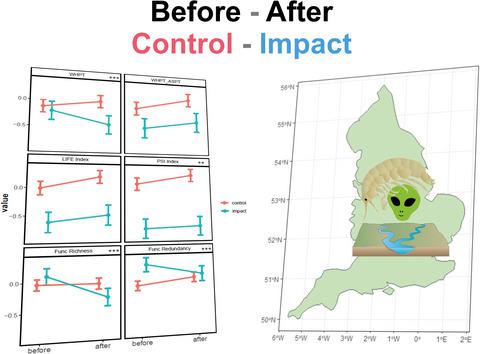当前位置:
X-MOL 学术
›
J. Appl. Ecol.
›
论文详情
Our official English website, www.x-mol.net, welcomes your
feedback! (Note: you will need to create a separate account there.)
Invasive species influence macroinvertebrate biomonitoring tools and functional diversity in British rivers
Journal of Applied Ecology ( IF 5.0 ) Pub Date : 2020-11-12 , DOI: 10.1111/1365-2664.13795 Simone Guareschi 1 , Alex Laini 2 , Judy England 3 , Tim Johns 3 , Martin Winter 3 , Paul J. Wood 1
中文翻译:

外来入侵物种影响英国河流中的大型无脊椎动物生物监测工具和功能多样性
更新日期:2021-01-07
Journal of Applied Ecology ( IF 5.0 ) Pub Date : 2020-11-12 , DOI: 10.1111/1365-2664.13795 Simone Guareschi 1 , Alex Laini 2 , Judy England 3 , Tim Johns 3 , Martin Winter 3 , Paul J. Wood 1
Affiliation

|
- Biological invasions could have major implications for the management and conservation of freshwater systems if they lead to a misclassification of waterbodies. However, there is limited understanding of the sensitivity of existing biomonitoring tools to invasive species in rivers; and even less known regarding how they influence community taxonomic and functional measures.
- This research explores the response of freshwater macroinvertebrate communities to biological invasion using taxonomic and functional indices. Utilising a long‐term dataset (spanning 2000–2019, 5,988 samples) from rivers in England, the performance of four biomonitoring tools (WHPT, WHPT‐ASPT, LIFE and PSI) and two community functional indices (functional richness and redundancy) was examined before and after the colonisation of the invasive species, Dikerogammarus haemobaphes (Eichwald, 1841; Crustacea: Gammaridae). This species represents a recent (first record 2012) and highly successful invader, allowing its range expansion within waterbodies to be examined in detail. Spatial (national and basin level) and seasonal (spring and autumn) effects were investigated using a before–after control–impact (BACI) experimental framework and linear mixed effects models.
- Results indicated that invasion by D. haemobaphes resulted in significant reductions to the WHPT index and functional diversity metrics (richness and redundancy) while more subtle patterns were observed for other metrics. Analysis of seasonal and individual river basins (River Trent and R. Thames) identified largely consistent responses. The establishment of D. haemobaphes also resulted in some modifications to the functional composition of aquatic communities primarily associated with voltinism and resistance features.
- Synthesis and applications. Our findings indicate that Dikerogammarus haemobaphes should be considered a significant pressure to riverine communities. These results have implications for biomonitoring, which informs managerial actions as effects may not be detected using a single taxonomic index. Community functional measures are useful in characterising the effects of invasive species and may form a valuable part of the ‘toolbox’ used for studying biological invasions in rivers. The research illustrates the need to consider the wider threats posed by invasive species on the long‐term integrity of freshwaters and the efficacy of freshwater biomonitoring tools.
中文翻译:

外来入侵物种影响英国河流中的大型无脊椎动物生物监测工具和功能多样性
- 如果生物入侵导致水体分类错误,则可能对淡水系统的管理和养护产生重大影响。但是,对于现有生物监测工具对河流中入侵物种的敏感性了解有限。关于它们如何影响社区分类和功能措施的了解甚少。
- 这项研究使用分类和功能指标探索淡水大型无脊椎动物群落对生物入侵的反应。利用英格兰河流的长期数据集(2000-2019年,共5988个样本),检查了四种生物监测工具(WHPT,WHPT-ASPT,LIFE和PSI)的性能以及两个社区功能指数(功能丰富度和冗余度)入侵物种定殖双歧杆菌的定殖前后(Eichwald,1841;甲壳纲:伽马科)。该物种代表了最近(2012年的最高记录)并且非常成功,因此可以详细检查其在水体中的扩展范围。使用前后影响对照(BACI)实验框架和线性混合效应模型研究了空间(国家和流域水平)和季节(春季和秋季)效应。
- 结果表明,D。haemobaphes的入侵导致WHPT指数和功能多样性指标(丰富度和冗余度)显着降低,而其他指标则观察到更细微的模式。对季节性和单个流域(特伦特河和泰晤士河)的分析确定了基本一致的响应。衣藻的建立也导致对水生群落功能组成的某些修改,这些功能主要与vol性和抗性有关。
- 综合与应用。我们的研究结果表明,应将双歧双歧杆菌视为对河流社区的重大压力。这些结果对生物监测具有启示意义,因为使用单一生物分类指数可能无法检测到影响,因此可以告知管理行动。社区功能措施可用于表征入侵物种的影响,并且可能构成用于研究河流生物入侵的“工具箱”的重要组成部分。研究表明,有必要考虑入侵物种对淡水的长期完整性和淡水生物监测工具的效力所构成的更大威胁。











































 京公网安备 11010802027423号
京公网安备 11010802027423号